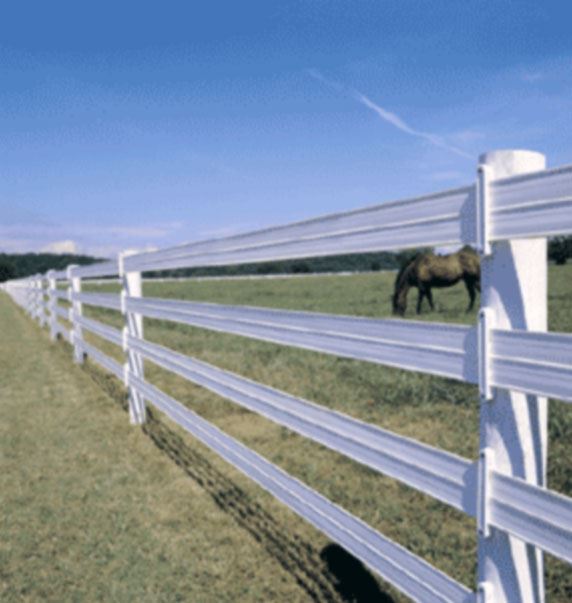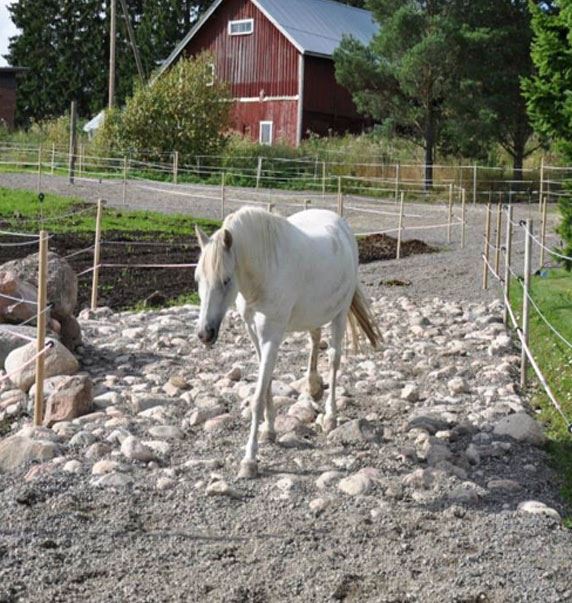- Home
- Pet Owners
- Advice for Horse Lovers
- Fencing
Fencing
Recommended Fencing Requirements for HorsesFencing a horse is a necessary part of ownership. Horses must be safely contained in their property so they do not cause a danger to themselves or others, however it can be a hard decision knowing what is best to use and as a force free horse owner, which type of fence in the safest but least aversive to the horse. We have prepared a list of fences that may be consider when fencing a horse. Size of housing
Firstly, it should be mentioned that horse require a certain amount of space to live in, when being kept which means the size of their paddocks should be a significant consideration when housing a horse. The Department of Primary Industries (1), states that horses need to have grazing areas big enough for amount of horses kept and they recommended size a size of 1ha as adequate, with a minimum size of 0.4 ha. The Five FreedomsPPGA recognises that as force free horse owner and trainers, we need to also consider the 5 freedoms and therefore recommends larger areas than this if space allows as a horse needs to be able to graze and move around freely and also be kept with other horses in order to fulfill the horses need for companionship (see Social Need and Environmental Enrichments). The DPI does not indicate the amount of horses to be kept in such an area however Mike Yoder, the Extension Assistant Professor & Specialist Extension Horse Husbandry at North Carolina State University recommends at least 2 acres for one horse and an extra acre for each horse kept thereafter (2). PPGA recommends at least this area or more if land permits as there should be enough room for horses to be able to move, run and feed and also for paddocks to be rotated regularly. Types of Fencing for Your Horse Post and rail or natural fencing such as stone or bushes. These are the gold standard of horse fencing as they provide a strong and sturdy fence which prevents injury and escape; is durable; long last and is also easy for the horse to see the fence. The rails of post and rail fencing should be attached to inside of posts to prevent being pushed off (1). Unfortunately post and rail fencing can be expensive and time consuming to set up and is often not used for this reason. If a horse owner is agisting their horse elsewhere then a post and rail fence is not always an option. Natural barriers such as hedges or stone walls are also common horse fences in the U.K. and act as a suitable barrier to prevent escape; unfortunately these types of fences are under-utilised or not possible in Australia but also should be considered if available. What is horse rail?Horse rail fencing is relatively new in Australia and often used on horse studs. It is made a premium grade polyethylene plastic with a strong steel core and is cheaper than post & rail fencing; easier to install and is durable, safe, long lasting. Being a bright white colour, it is easy for the horse to see, therefore preventing horses accidentally running in to it. Horse Rail is not as strong as post and rail and it can flex over time with livestock leaning on it. Barbed wire or wire fencing for your horseThis type of fencing is not recommended to contain horses due to the high risk of injury. Horses can become entangled in fencing and cause significant injury when trying to escape. Unfortunately, some horse owners find their horses with this type of fencing at agistment places and have no choice. If used it is recommended that a sight line be used on the top of the fence in order for the horse to be able to see the fencing, and therefore hopefully prevent accidental running into it. Barb wire and wire fencing is cheap to install and maintain but it is also not as long lasting as other fencing options as horses may lean on it cause the fencing to loosen which may increase the risk of the horse escaping. As stated it is not recommended, if at all possible, due to the risk of injury to the horse. Electric fencingWhilst PPGA does not recommend the use of electric fencing as it is an aversive stimulus which does not align with our force free ethics, we do acknowledge that it is often the only options for many horse owners in an agistment situation, or the only viable option on a larger property to allow paddock regrowth. If using electric fencing we recommend having an area large enough so the horse does not need to come in contact with the fence unnecessarily (i.e. we do not condone the use of electric fences at events where the horse is contained to a very small area and cannot move around freely). Visual stimuli should be place on the fence so the horse can clearly see there is a barrier (for example, white flags hung on the fence). Electric fencing is cheap and portable; however, it is aversive for horses, and may not be as safe as post and rail or horse rails as horses can run through it and get tangled if they get a fright despite the electrical impulse. PPGA acknowledges that many horse owners may not have other options and provided that the 5 freedoms are met and the horse can move freely away from the fence, we see electric fencing as a suitable containment for horse safety and environmental management as well. Paddock Rotating & Track Systems
For example, in some areas of Australia the grass becomes burnt and dried out by the sun in the hot summer months or becomes dormant during winter months in colder climate areas. In spring, the oversupply of the green sugary grass may be a risk to some horses who are prone to laminitis and therefore paddock restrictions may be necessary (3). During these times, a track system is a fabulous idea in order to restrict the horses’ access to inappropriate forage but also to give them a novel and environmentally enriching area to exercise in. A track system encourages horses to keep moving while grazing and you can put in different types of environmental stimuli in order to keep your horses entertained. Ideas such as branches to step over; a water source such as a dam to swim or wade through; slow feeder hay nets hung in different locations around the track; enrichment horse safe toys and different ground surfaces to step on. This type of system simulates a horses’ natural instincts as a herd to keep moving while grazing and to be on grounds that is not just lush pastures. We discuss track systems in more detail in our Environmental Enrichment handout. References
|


 Whilst we have encouraged the need for horses to have significant areas to live in in order to have access to free forage, companionship and freedom of movement, we also recommend horses be rotated into different paddocks regularly in order to allow pasture regeneration. In some parts of Australia this is especially due to insufficient or inappropriate forage winter months being available during some seasons.
Whilst we have encouraged the need for horses to have significant areas to live in in order to have access to free forage, companionship and freedom of movement, we also recommend horses be rotated into different paddocks regularly in order to allow pasture regeneration. In some parts of Australia this is especially due to insufficient or inappropriate forage winter months being available during some seasons.